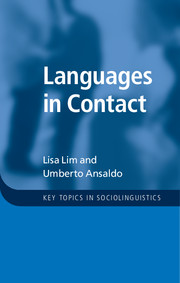Book contents
- Frontmatter
- Contents
- List of figures
- List of tables
- Preface
- Acknowledgements
- List of abbreviations
- 1 Perspectives on contact
- 2 Contact and code choice
- 3 Contact and creole formation
- 4 Contact and language evolution
- 5 Contact and ecology
- 6 Contact and shift
- 7 Contact and globalisation
- 8 Reflections and future directions
- References
- Index
8 - Reflections and future directions
Published online by Cambridge University Press: 05 November 2015
- Frontmatter
- Contents
- List of figures
- List of tables
- Preface
- Acknowledgements
- List of abbreviations
- 1 Perspectives on contact
- 2 Contact and code choice
- 3 Contact and creole formation
- 4 Contact and language evolution
- 5 Contact and ecology
- 6 Contact and shift
- 7 Contact and globalisation
- 8 Reflections and future directions
- References
- Index
Summary
THE STATE OF OUR FIELD
In conceptualising and developing the themes of our book, we have made an effort to be forward looking, as well as eastward minded, in order to present fresh – at times challenging – theoretical views and offer novel empirical content. It seems therefore apt at this point to look back and ask ourselves where we have come to in the field of contact linguistics.
The study of language contact can hardly ever be dissociated from one thinker in particular who, in a short lifespan, made impressive contributions: Uriel Weinreich, mentioned at the outset of this book. Credited by many as the father of modern contact linguistics, his views have time and again proven to be some of the most insightful of our field. As we are now six decades beyond the date of his most influential publication, Languages in Contact (1953), we take Weinreich's legacy as the benchmark for our field and for the contributions of this very volume. From a methodological point of view, Weinreich had already established a tradition that continues to this date – namely an intimate relationship between contact and sociolinguistics. His work was to be of great influence for William Labov (Kim 2011) and established early on an important fact: that solid contact linguistics must be closely related to the study of social, cultural and political issues. The outcomes of language contact, which Weinreich calls 'interference’, were to be in large part understood on the basis of social variables, demographic as well as historical factors, gender and race, and institutional as well as political functions. In this respect, Thomason and Kaufman's (1988) model of contact, while paying close attention to structural issues in language contact, also reinforces the notion of sociohistorical dynamics as the fundamental explanatory dimension in the study of borrowing and shift.
Thomason and Kaufman also argue against the possibility of structural constraints as an explanatory dimension. Following in these eminent footsteps, our own contribution can be seen as basically a work of sociolinguistic nature, albeit focused on contact.
- Type
- Chapter
- Information
- Languages in Contact , pp. 187 - 204Publisher: Cambridge University PressPrint publication year: 2015



